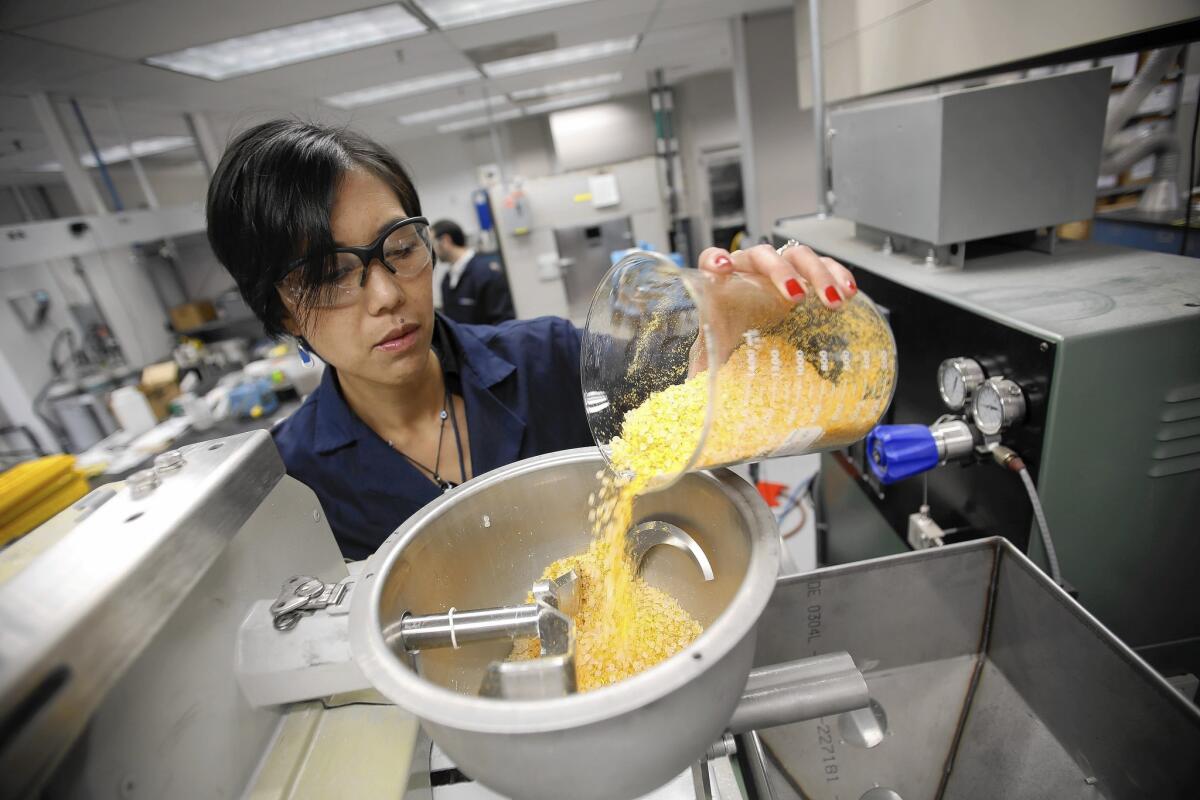Ford is burning (sustainable) rubber in push to go green

- Share via
Ford Motor Co. and H.J. Heinz Co. are trying to turn tomato skins into floor mats.
The car company is also working with soybean farmers, who are helping its engineers turn soy oil into seat cushions, and with the U.S. Department of the Treasury, which is helping it mold shredded U.S. currency into coin trays.
The effort is part of Ford’s biomaterials team’s push into non-petroleum-based alternatives to traditional plastics. The goal is to reduce weight and increase fuel economy by using inexpensive, environmentally friendly materials that might otherwise become landfill.
“Our sustainable materials strategy [is] embodied by a ‘reduce, reuse and recycle’ commitment,” said Ellen C. Lee, team leader of Ford’s plastics research division. She recalled a meeting with Heinz, where she was told the company used 2 million pounds of tomatoes a year to make ketchup — and there was a byproduct Ford could use.
“That got our attention,” Lee said.
Ford vehicles already feature recycled jeans and T-shirts (turned into interior padding), recycled wood (turned into interior trim), recycled yarn (microsuede for upholstery) and a kind of hibiscus plant fiber known as kenaf (door bolsters).
The company’s Flex has wheat straw in the plastic storage bins. Ford’s Focus Electric has recycled plastic water bottles in its seat covers. The Escape dashboard contains about 10 pounds of bluejeans, T-shirts and sweaters.
Now the company is looking into turning dandelion and marigold pulp into a non-petroleum-based rubber, for automotive trim and tires, and is in the early stages of a deal to recycle millions of pounds of retired U.S. currency into interior parts such as coin trays.
“I don’t know if it would be right for every customer, but it fits with the theme,” Lee said. “You could actually see that it is shredded money.”
The interest in cheap, sustainable products for automobiles is part of Ford’s heritage, company officers say. Founder Henry Ford built and unveiled a “soybean car” in 1941. It featured soy oil-based plastic panels and weighed 1,000 pounds less than a conventional Ford. The panels didn’t dent or ding.
But Ford isn’t the only company pushing into new plastics.
Honda representatives say that in 2006 the company began using a corn-based “bio-fabric” for seating material that’s now included in its Accord Plug-In and Fit EV, two low-volume green vehicles. The company also uses a byproduct of sugar cane to make a type of plastic.
According to Toyota, the company was putting PET plastic components in some Prius and Lexus vehicles as early as 2007. Toyota has also for several years been using kenaf plant fibers for scuff plates and seat cushions in some cars, and uses bamboo charcoal in the manufacturing of its speaker cones.
Lee came to Ford early in her career, after graduate work at UC Berkeley.
She joined a biomaterials team that was looking into ways to create a seat cushion foam using soybean oil. In 2007, after six years of work, the product went into a vehicle — as part of the seat cushions for the 2008 Mustang.
The material migrated to other Ford vehicles and other applications. Now, Lee said, some sort of soy-based foam is in every Ford on the road, often as headrests. The company is also trying to use the product to make headliner and armrests.
The company is also part of the Plant PET Technology Collective, a consortium formed with Heinz, Coca-Cola Co., Nike Inc. and Procter & Gamble Co. The companies have pooled resources to figure out, among other things, how to abandon conventional plastics in favor of a plant-based plastic. The members of the group, formed in 2012, are using the plant-based plastic to make bottles, apparel, footwear and automotive carpet.
Coca-Cola is already making bottles that are 30% plant-based, Lee said.
“We want to push that from 30% to 100%,” she said.
The push into sustainable materials is about profits as much as the environment. Ford’s biomaterials website notes that a barrel of oil cost about $16 in the early 2000s, when the automaker first started researching reusable materials. Today, a barrel of oil might go for $115 or more.
The company says its use of soybean-based plastics reduces its petroleum consumption by 5 million pounds a year.
Don Anair of the Union of Concerned Scientists applauded the effort but suggested that automakers stay focused on reducing fuel consumption.
“There’s a general trend in many industries to find ways to use recycled materials,” Anair said. “But the biggest impact on the environment is the vehicles they make and the fuel they need to burn to operate.”
Several Ford representatives stressed that the use of natural products was, as Lee said, “in our company DNA.” Founder Ford was obsessed with finding ways of getting agriculture and automotive to work together. He put wheat straw into the steering wheel of his early automobiles and used hemp fibers to produce early car parts.
He was so enamored by the soybean that he had a suit made from soybean “wool.”
“The problem was,” Lee said, “he didn’t know how to clean it, so it never got washed.”







